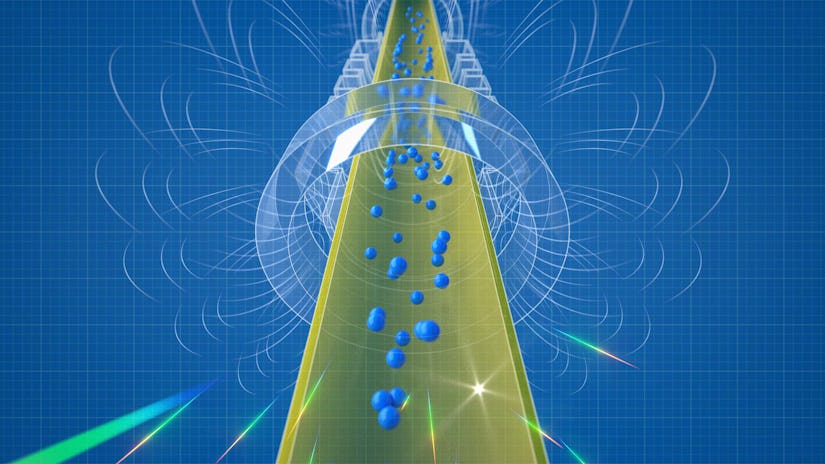
Posted on 10/06/2023 7:57:56 AM PDT by Red Badger
Dreams of a world powered by antigravity got quashed by a particle physics today.
~~~~~~~~~~~~~~~~~~~~~~~~~~~~~~~~~~~~~~~~~~~~~~~~~~~~~~~~~~~~
It turns out that Einstein was right yet again. A recent experiment just proved that antigravity doesn’t exist and we probably won’t ever get to use antimatter to levitate or build a perpetual motion machine or power warp drives (sorry, Star Trek).
Antimatter itself is very real. Made of particles that mostly behave like regular matter, but their electrical charges are reversed, an anti-proton looks just like a proton but has a negative charge, while an anti-electron (or positron) looks and moves just like an electron but has a positive charge. When a bit of antimatter bumps into a bit of matter, they explode so dramatically that all of their combined mass is converted into energy.
Now we know that matter and antimatter are drawn toward each other — not pushed apart — by gravity. Physicist Albert Einstein predicted this in his theory of general relativity years before the first positron was discovered, but Aarhus University physicist Emma Anderson and her colleagues at ALPHA (the Antihydrogen Laser Physics Apparatus) just tested the theory by watching atoms of anti-hydrogen — a single anti-electron orbiting an anti-proton — fall downward under the pull of Earth’s gravity.
The researchers recently published their work in the journal Nature.
AU REVOIR, ANTIGRAVITY
In a nutshell, Anderson and her colleagues dropped atoms of antihydrogen down a tube, and the atoms fell downward thanks to gravity. That sounds simple, and in fact, it’s exactly what Einstein predicted would happen — but it hadn’t been done before. Until now, there was a lingering chance that antimatter wouldn’t feel the tug of Earth’s gravity, or that matter and antimatter actually experienced a sort of antigravity, pushing each other apart.
To make anti-hydrogen, you need to combine positrons and anti-protons. Anti-protons are produced in high-energy particle collisions, then slowed down in what's called an antiproton decelerator at CERN (which is also home to the Large Hadron Collider). Positrons come from radioactive decay of certain chemical elements, like potassium.
Once you have the antimatter, you face the challenge of working with something that will disappear if it touches even another atom of ordinary matter. The team used an eight-pole magnet to keep antihydrogen atoms swirling along the magnetic field lines and away from the deadly walls of the container. Anti-atoms with enough energy (anti-atoms that were moving fast enough, in other words) could still escape, but slower ones would be trapped inside the magnetic field.

This illustration shows what anti-hydrogen atoms falling through the magnetic trap might look like if we could actually see them. - NATIONAL SCIENCE FOUNDATION
When the researchers turned their tube of captured antimatter vertically, they found that the atoms moving downward along the magnetic field lines sped up thanks to the added pull of gravity; the atoms moving upward slowed down, also thanks to gravity trying to pull them Earthward. Anderson and her colleagues couldn’t actually watch the anti-atoms in action, of course, but their instruments counted the tiny flashes of energy every time an anti-hydrogen atom, pulled downward by gravity, gained enough speed to punch through the magnetic field at the bottom of the container and escape, annihilating itself and an unfortunate atom of regular matter in the process.
“To do the experiment, you're actually just turning down the current that makes the magnetic field,” Hangst tells Inverse. “You have a cloud of [anti-hydrogen atoms] bouncing around, and you let them go.”
When that happened, about 80 percent of the anti-hydrogen atoms fell toward Earth. The rest, about 20 percent, were still bouncing upward fast enough to keep going. That’s pretty much the result you’d expect from a tiny cluster of regular hydrogen atoms bouncing around in a magnetic field, too.
That suggests that matter and antimatter both feel the pull of Earth’s gravity in the same way, which means matter and antimatter are attracted, not repelled, by each other’s gravity. In other words, the experiment confirmed that matter and antimatter are drawn together, just like all the other mass in the universe, regardless of their weird properties.
“If you walk down the halls of the department and ask the physicists, they would all say that this result is not the least bit surprising, but most of them will also say that the experiment had to be done because you can never be sure,” says University of California at Berkeley physicist Jonathan Wurtele, a coauthor of the study, in a recent statement. “You don’t want to be the kind of stupid that you don’t do an experiment that explores possibly new physics because you thought you knew the answer, and then it ends up being something different.”
WHERE’S ALL THE ANTIMATTER?
While we can’t use antimatter to levitate or power a perpetual motion machine, we also can’t blame antigravity for shoving all the antimatter out of the universe we see around us, which would have been a convenient way to explain the one prediction of Einstein’s that antimatter definitely doesn’t seem to obey.
According to general relativity, antimatter and matter should exist in equal amounts. But there’s almost no antimatter in the universe, or at least anywhere in the universe we can see and measure. And that raises important questions, like where the heck did it all go?
One idea was that shortly after the Big Bang, matter and antimatter basically gave each other a giant shove apart, separating each other once and for all except for a few tiny, scattered particles. But Anderson and her colleagues’ experiment proves that’s just not how antimatter works, leaving physicists with another big mystery to solve.
WHAT’S NEXT
By varying the strength of the magnetic field — and thus varying how fast anti-atoms had to move in order to punch through it and escape — Anderson and her colleagues managed to measure how much the pull of gravity accelerated the antimatter. The answer turned out to be around 32 feet per second (per second), which is roughly how much Earth’s gravity accelerates ordinary falling matter, too.
One of the next steps is to measure that even more precisely to make sure there’s not really any small difference in how much antimatter accelerates as it falls downward. In other words, that it feels gravity’s pull just as strongly as regular matter, not more or less.
But for now, Anderson and her colleagues are focused on studying how antimatter interacts with radiation. If Einstein’s predictions are correct, anti-hydrogen should absorb, emit, and reflect the same spectrum of light as regular hydrogen — so Anderson and her colleagues will spend the next year or so zapping antimatter with lasers and microwaves to find out.

Cloud chamber photograph of the first positron ever observed. The thick horizontal line is a lead plate. The positron entered the cloud chamber in the lower left, was slowed down by the lead plane, and curved to the upper left. The curvature of the path is caused by an applied magnetic field that acts perpendicular to the image plane. The higher energy of the entering positron resulted in lower curvature of its path. Original caption: A 63 million volt positron (Hρ = 2.1×105 gauss-cm) passing through a 6 mm lead plate and emerging as a 23 million volt positron (Hρ = 7.5×104 gauss-cm). The length of this latter path is at least ten times greater than the possible length of a proton path of this curvature.
This does not ‘prove’ that antigravity does not exist.
It merely proves that antimatter doesn’t create it..............
“More crap based on existing theories.”
Or rather based on experimental evidence.
Get ahold of yourself. The experiment was designed to test whether of not antimatter atoms would fall up or down in earth’s gravity field. That is all the experiment attempts to demonstrate. It does not have to be accepted as dispositive or final, but it constitutes empirical EVIDENCE for the hypothesis under test. It actually ADDS to the net sum of human knowledge, unlike computer simulations, speculation and ignorant harping.
“The anti-hydrogen atoms and the hydrogen atoms, were not free to decide on their own, because, they were trapped in a magnetic field which left them with no choice(s).”
No, it only restricted their movement laterally. They were free to move up or down, and they all “chose” down.
GMTA.
Einstein was right. I just confirmed it.

By "cloud chamber photograph", is that a literal photograph (the capturing of light). Or is that a derived "image" like from an MRI (where the "I" in "MRI" stands for "image" but it's not a literally image made from light, it's a topography derived from detecting deviations in the magnetic field).
If it's a literal photograph that gives me a whole new perspective and respect for the accuracy of results from experiments like this.
Especially Bob Lazar!
Maybe they would, if any of them would consent to be interviewed.
Seems like your anti-matter would have to have negative mass for this to work.
“that would be antigravity and no one can prove it didn’t happen”
Except according to relativity, it doesn’t actually matter if you choose to view it that way, the results will still be the same.
That’s a real photograph. What you are seeing is not the actual positron itself, though, but a path of little bubbles that are released as a particle passes through the liquid.
“lateral movement might have indicated that, the anti-gravity existed towards the sides”
Then it wouldn’t be anti-gravity. Some other force perhaps, but not anti-gravity, since anti-gravity would show a repulsion opposite the center of all the mass in the local area (the center of the earth).
“you demonstrated that you can’t detect sarcasm”
When people in all seriousness post complete ignorance on science threads, it’s often impossible to detect sarcastic posts.
It’s a photograph of condensation caused by the passing positron.
It would be sort of like debating Flat Earthers: nigh impossible to tell which ones are trolling you or which ones actually believe it, because part of you is always thinking 'they can't REALLY be that stupid or ignorant, can they?'.
Disclaimer: Opinions posted on Free Republic are those of the individual posters and do not necessarily represent the opinion of Free Republic or its management. All materials posted herein are protected by copyright law and the exemption for fair use of copyrighted works.